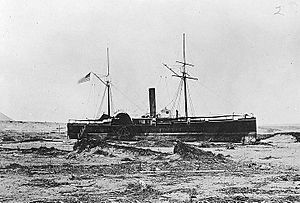USS Wateree (1863) facts for kids

Beached at Arica, 430 yards beyond the usual high water mark, after she was deposited there by a tsunami on 13 August 1868.
|
|
Quick facts for kids History |
|
|---|---|
| Name | USS Wateree |
| Builder | Reaney, Son & Archbold, Chester, Pennsylvania |
| Launched | 12 August 1863 |
| Commissioned | 20 January 1864 |
| Fate | Sold, 21 November 1868 |
| General characteristics | |
| Class and type | Sassacus-class gunboat |
| Displacement | 1173 tons |
| Length | 240 ft (73 m) |
| Beam | 35 ft (11 m) |
| Depth of hold | 11 ft 6 in (3.51 m) |
| Speed | 10 knots (19 km/h; 12 mph) |
| Armament |
|
The first USS Wateree was a special type of ship called a sidewheel gunboat. It served in the United States Navy during the American Civil War. Gunboats are smaller warships that carry guns and can operate in rivers or close to shore.
The Wateree was built in Chester, Pennsylvania, by a company called Reaney, Son & Archbold. It was launched on August 12, 1863. The ship officially joined the Navy on January 20, 1864, at the Philadelphia Navy Yard. Comdr. F. E. Murray was its first commander.
Contents
Voyage to the Pacific Ocean
Soon after joining the Navy, the Wateree was sent to the Pacific Squadron. This meant it had to make a very long and difficult trip around Cape Horn. Cape Horn is at the southern tip of South America and is known for its rough weather.
The journey took about 10 months. The ship also had trouble finding enough fuel. Because of this, it had to stop many times along the way to get wood for its boilers. The Wateree finally reached San Francisco in mid-November 1864.
Repairs and Patrols
When the Wateree arrived in San Francisco, it needed repairs. The long journey had damaged the ship. It also needed its hull cleaned at the Mare Island Navy Yard.
The ship left San Francisco in late February 1865. Its job was to patrol the coast of Central America. In 1866, the American naval forces in the Pacific were split into two groups: the North Pacific Squadron and the South Pacific Squadron.
The Wateree joined the South Pacific Squadron. This group's patrol area was huge. It stretched from Panama south to Cape Horn and west all the way to Australia. For the next two years, the Wateree patrolled the coasts of Central and South America. Its main mission was to protect American interests in that area.
The Great Earthquake and Tsunami
The Wateree was helping to enforce the Monroe Doctrine. This was a policy that warned European countries not to interfere in the Americas. At the time, Peru had declared war on Spain in January 1866.
To avoid a yellow fever outbreak in Callao, Peru, the Wateree moved south to Arica, Peru. Arica is now part of Chile. On August 13, 1868, a huge earthquake, known as the 1868 Arica earthquake, hit the city while the Wateree was in port.
A Ship Carried Inland
At 5:20 PM, the crew of the Wateree saw dust from the earthquake and buildings collapsing. But the sea stayed calm. The ship sent a boat ashore to offer medical help.
After the boats were ashore, a series of ten tsunamis hit. A tsunami is a giant ocean wave caused by an earthquake. The first wave surged inward, reaching about 34 feet (10 meters) above the normal high tide line. All the ships anchored in the harbor were pushed onto land when the water flowed back out.
The next incoming wave was even bigger, about 46 feet (14 meters) high. This massive wave broke the Wateree's anchor chains. It then carried the ship about 450 yards (411 meters) inland. The Wateree landed about 3 miles (5 kilometers) north of Arica at 7:20 PM.
The ship that was with the Wateree, the USS Fredonia, was completely destroyed. Almost everyone on board the Fredonia drowned. However, on the Wateree, only one person, the boatswain who was ashore, was hurt.
After the Disaster
Amazingly, the Wateree was still in one piece and sitting upright on land. Its crew immediately helped the people of Arica. They provided supplies and aid to the civilians who had lost their homes.
The ship was too far inland to be moved back to the sea. So, it was sold on November 21, 1868, for $2,775 to a man named Mr. William Parker.
For many years, the hulk of the Wateree was used for different purposes. It served as an emergency hospital, then an inn, then a hospital again, and finally a warehouse. The ship was eventually completely destroyed by another tsunami on May 9, 1877.
Remains of the Wateree
Today, you can still see parts of the Wateree's boilers. They are located on the shore north of the modern town of Arica. These remains are kept as a National Monument of Chile, reminding people of the ship's incredible story.
Images for kids
See also
 In Spanish: USS Wateree (1863) para niños
In Spanish: USS Wateree (1863) para niños


